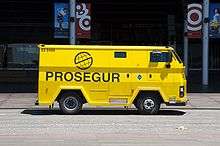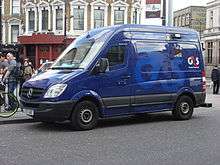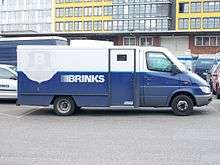Armored car (valuables)
An armored vehicle (or armored cash transport car, security van) is an armored van or truck, used in transporting valuables, such as large quantities of money (especially for banks or retail companies). The armored car is typically a multifunctional vehicle designed to protect and ensure the wellbeing of the transported individuals and/or contents. Often, armored cars are bulletproof and can withstand extreme degrees of heat. These vehicles are mostly utilized by the military, but many companies such as Mercedes, Lexus, Toyota, Cadillac, Audi, and BMW have created armored cars for civilian use, usually to protect valuables and dignitaries. Armored cars have an armored shell and cab, and typically are customized on a basic van or truck chassis. These vehicles are designed to resist attempts at robbery and hijacking. Bullet-resistant glass and reinforced shells and cabs are designed to resist bullets from most handguns and rifles.

History
The idea of the armored vehicle dates back to Leonardo da Vinci's sketches of an armored war vehicle, in 1485. It consisted of a circular platform on four wheels with light cannons arranged facing out.[1]
The earliest form of armored transportation for valuables that actually went into production were the "ironclad" treasure wagons designed by the Cheyenne and Black Hills Stage Company during the American Old West.[2] Back then, a platoon of soldiers and cavalrymen were used to transport valuables such as gold safely across the lawless frontier. They were not always successful in escorting their valuables, and some robbers managed to hold up and rob these transports, such as what happened in the Wham Paymaster robbery and the Skeleton Canyon massacres. In Deadwood, the Cheyenne and Black Hills Stage Company suffered robberies along the criminal-infested Deadwood to Cheyenne trail that also resulted in the death of one of their shotgun messengers named Johnny Slaughter. In order to deter bandits and prevent future robberies, the Stage Company built two steel-plated treasure coaches named Slaughter (after the former shotgun messenger) and Monitor (after the famous USS Monitor in the Civil War). The stagecoaches had 5/16th-inch thick steel plates, portholes for guards to shoot from, and inside of each coach was a strongbox with walls three inches thick that was bolted to the floor, and was said to be able to resist assaults for 24 hours. Although the stage coaches were impenetrable, they still left its driver and shotgun messenger unprotected.[2] On September 26, 1878, the Monitor was attacked by the Charles Carey Gang as it left Deadwood. The gang killed one of the passengers, stopped the carriage and took over $27,000 worth of gold and valuables.
Among the first armored cars built was the Bellamore Armored Motor Bank Car, of 1910, which was meant to function like the banking service armored cars of today, but also as a mobile bank branch.[3] It was built on an Autocar Type XXI truck.[4] It was not until Rolls-Royce came out with the Rolls-Royce Ghost in August 1914 that the first armored vehicle was introduced to the British military. The vehicle proved to be superior during the war, creating a demand for armored cars across the globe. In 1930, Mercedes Benz introduced the Nurburg 460, which was an armored car used to protect Pope Pius XI. As the armored car became more and more popular, vehicle manufacturers around the world started creating their own versions.
Industrial business use
Financial industry: the armored car is used to transport money from one destination to another safely. This benefits the bank because it gives the bank employees more time to work with the customers, and provides a security net to the owner knowing their money is in good hands.
Education industry: schools utilize the armored car for safely transporting money made by school fund raisers or cafeteria profits. Many universities have within their confines a university bank, and they may require the use of an armored car to handle large amounts of money.
Jewelry industry: many jewelers such as Jared, Kay, Rogers and Hollands, and Tiffany Co utilize armored cars to transport their valuable jewelry safely to their stores. Jewelers work with precious metals and valuable gemstones, and they need to make sure that their work can be safely carried to the person who has ordered it.[5]
Vehicles

An armored shell and cab are customized on a basic van or truck chassis. These vehicles are designed to resist attempts at robbery and hijacking. Bullet-resistant glass and reinforced shells and cabs are designed to handle bullets from most handguns and rifles.
Traffic safety and security
Some armored cars in certain countries may be cleared to have flashing warning lights or sirens. Most armored cars have a bull bar or extra strong bumper to ram blockades or other road objects if under attack. They normally have CCTV cameras which are watched by the driver, recorded in the van and also recorded at a remotely located control room in case the in-van recordings are stolen by thieves or attackers.
Access control
A number of tools are applied to prevent access to the van by non-security staff including removing external door locks.
The vehicle may or may not be manned by armed guards. Such armored cars are usually operated by security firms, and are therefore often referred to as "security vans".[6]
Guards
Most armored cars have two to three occupants:
- A driver, who is normally never allowed to leave the vehicle until it returns to the garage
- One or two guards who deliver the cash or valuables
Their main duty is to stay watchful, and to load and unload the valuables as fast as possible.[7]
Depending on the jurisdiction, the guards may be armed, sometimes with handguns on their person and shotguns in the vehicle. These guards are required to undergo firearms training and may have to apply for and have permits for being a guard or to carry an exposed firearm. Training may also include: guidance on remaining calm in emergency situations, such as confronting armed criminals, assisting injured colleagues, and notifying local law enforcement, following traffic rules and choosing the safest routes for transportation.[7]
Five member states of the European Union, namely Denmark, Greece, Ireland, Sweden, and the Netherlands, as well as the United Kingdom, prohibit weapons during cash-in-transit (CIT) operations.[8] In parts of the United States, such as New York State, armored car guards are permitted to carry weapons after reasonable checks.[9][10]
In some jurisdictions, armed car guards are required to wear bullet-proof vests[11] and sometimes ballistic helmets.[7]
Firms
List of firms using armored cars:
- Inkas Armored
- Garda
- Securicor—sold to G4S
- Wells Fargo—sold to Loomis
- Armaguard
- Prosegur
- Grupo Protege
Alternatives
Intelligent banknote neutralisation systems are often used as an alternative to armored cars or as a complementary protection for CIT (for example, in semi-armored cars).[8]
Other uses
Despite their primary function as a safe means to transport valuable materials from one place to another, armored cars are occasionally used for other purposes. For example, during the 1997 North Hollywood shootout, police officers in Los Angeles commandeered an armored car in order to extract wounded civilians and officers from the scene towards the end of the shootout.[12] This later led to the introduction of specialist police vehicles for similar situations.
In popular culture
The armored car has been utilized in many crime or action films and video games because of its worldwide recognition as a high-security-level vehicle carrying valuables. Some early examples include the films Armored Car Robbery (1950) and The Breaking Point (1960), as well as the Grand Theft Auto video game series.
See also
- Non-military armored vehicles
- Cash-in-transit
References
| Wikimedia Commons has media related to Armoured vans. |
- Hall-Geisler, Kristen. "How Armored Cars Work". How Stuff Works. Retrieved 2011-09-20.
- Markley, Bill. "The Original War Wagon". True West Magazine. November 24, 2015
- Weis, Bernard J, "Dollars at Your Doorstep, Mr. Bellamore's Bank-On-Wheels", p.54, Special Interest Autos #81, June 1984.
- http://www.coachbuilt.com/bui/b/bellamore/bellamore.htm
- "Diplomatic Security". Archived from the original on 2011-10-10. Retrieved 2011-09-20.
- "Security van definition and meaning | Collins English Dictionary". www.collinsdictionary.com. Retrieved 2018-04-05.
- "What Are the Duties of an Armored Truck Guard?". Retrieved 2018-04-05.
- A comparative overview of the legislations governing the Cash in Transit private industry in the 15 EU members Archived 2009-01-05 at the Wayback Machine. CoESS / UNI-Europa joint Report. October 2004, p. 14.
- "Armored Car Guard". New York State.
- "Armored Car Carriers and Armored Car Guards" (PDF). New York State. June 2012.
- http://www.pssg.gov.bc.ca/securityindustry/worker/docs/armoured-car-guard.pdf
- Critical Situation, "North Hollywood Shoot-out".
